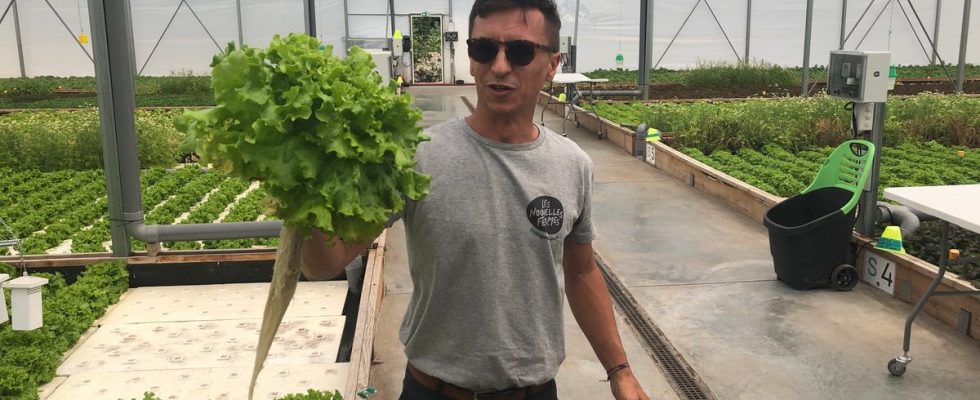No dirt under your shoes or bucolic smells when passing under the greenhouse in metal structure and covered with plastic tarpaulins which houses the production of “New Farms” but a good blow of heat. For about a year, twelve kinds of plants (herbs, salads, tomatoes, etc.) have been growing above ground, on 5,000 m2 in Mérignac near Bordeaux, after the five founding friends of the company tested their idea beforehand, on 1,000 m2 in Lormont.
They do not use synthetic fertilizers but use the droppings of their 4,000 rainbow trout to provide their plants with 90% of the nutrients they need. An additional biosourced fertilizer, around 10%, is added to the water in which the roots of the plants fixed on sorts of rafts are bathed. The group brings together 30 employees, nine of whom work directly at the Mérignac site.
When we hear the croaking of frogs, Thomas Boisserie, one of the co-founders of “Nouvelles fermes”, feels obliged to specify that it is not a recording. “We are not in a clean room,” he slips. Under the greenhouse, the atmosphere is really more like that of a thriving start-up than a traditional farm.
“We meet 1% of Bordeaux Métropole’s salad needs”
The Mérignac site produces 60 tonnes of fresh produce and 12 tonnes of trout using only 1,200 m 3 of water, compared to ten times more in an earthen market garden. “We meet 1% of Bordeaux Métropole’s salad needs and 4% of its trout needs with only 5,000 m2”, underlines Thomas
This urban aquaponic farm (contraction of aquaculture and hydroponics), located at the gates of Bordeaux, near Mérignac airport is presented as very productive while consuming little energy and not requiring synthetic products. “We use five times less energy than growing in the ground,” points out Thomas Boisserie. It records approximately 30% of losses on these plants (diseases, attacks of fungi, etc.) when this can go up to 50% for conventional market gardening operations.
Trout are raised in four tanks arranged in a U-shape in an opaque part of the greenhouse. Coming from Normandy, they arrive with a weight of approximately 300 grams and are fed with 80% plant-based croquettes and 20% animal croquettes, produced in Gironde. The tanks contain 20 to 25 kg of fish per m3. “We have found a good balance [sur cette densité] to prevent the trout from becoming territorial and there being predation”, specifies the co-founder. Trout droppings are naturally transformed by a passage in a tank during which the ammoniacal nitrogen is degraded into nitrate. The nutrient-laden water is sent to the plant ponds after passing through a small waterfall to oxygenate it, a journey that takes about three hours.
Profitability from 2024
In general, this varies according to the seasons, the prices of the products of this urban aquaponic farm are 15 to 20% lower than those of organic vegetables and they are marketed, for fresh plants, within a radius of 20 kilometers from the place of production. . It’s a little more for the flesh of the trout raised on site.
To install the site, built to measure for this particular aquaponics project, 1.2 million euros were invested, a quarter of which was subsidized by public actors. The same sum was invested upstream in research and development, thanks in particular to fundraising from private companies. “The site will start to be profitable and we hope for a turnover of 900,000 euros from 2024”, specifies Thomas Boisserie.
The Girondin site is one of the largest aquaponic farms in Europe, but “Les Nouvelles fermes” does not want to stop there. “We are also aiming for development in some of the ten largest cities in France soon and we are thinking about growth at European level”, concludes Laura Gaury, co-founder. According to “Les Nouvelles fermes”, greenhouse vegetables are the future.

